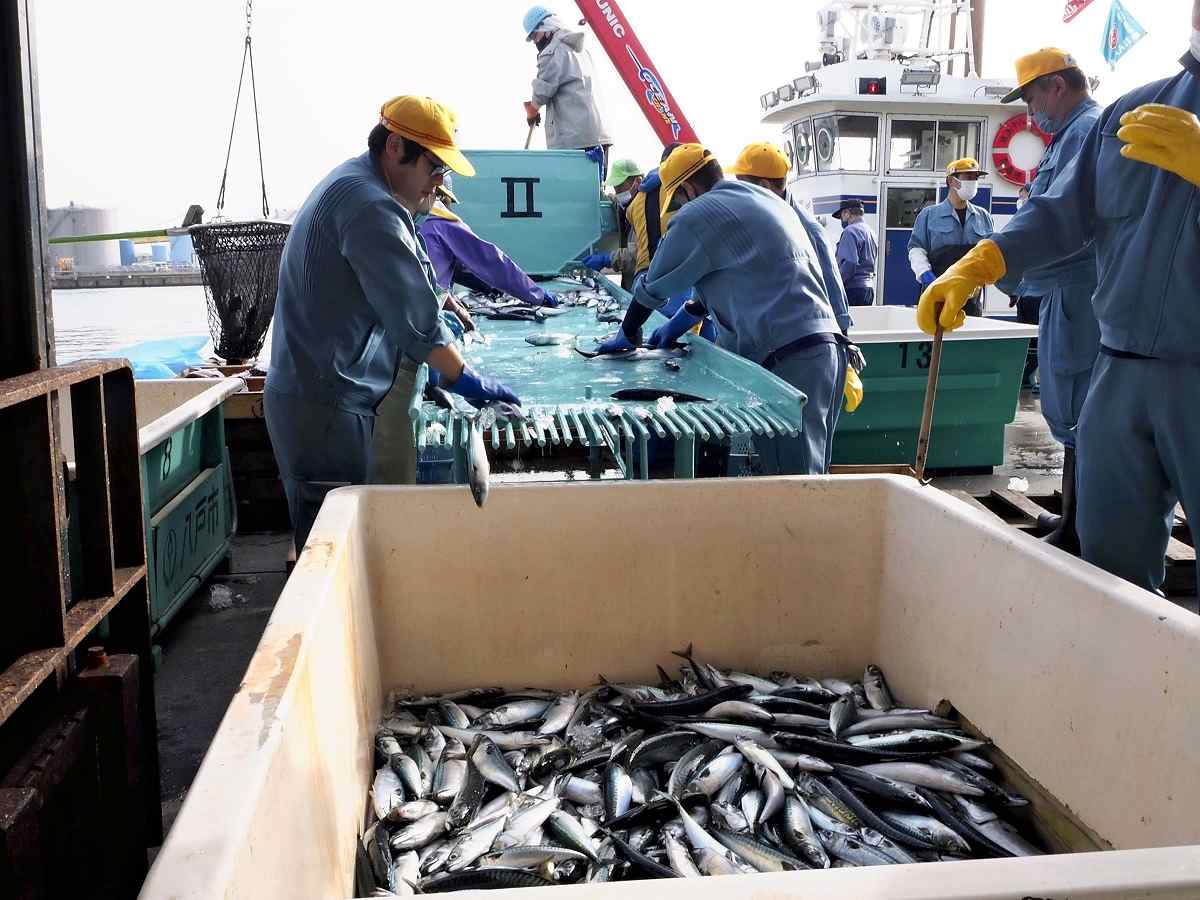
Mackerel is landed at the port in Hachinohe, Aomori Prefecture, on May 22.
12:47 JST, June 7, 2023
Japan’s fish haul, including farmed fish, fell by 7.5% in 2022 from the previous year to 3.86 million tons, according to statistics released by the Agriculture, Fisheries and Forestry Ministry.
Mackerel and bonito catches saw a particularly large drop, causing the total catch volume to hit its lowest point since 1956, the year with the oldest comparable data. The volume continues to decline due to changes in the marine environment, making the need for stronger resource management a global problem.
Marine fisheries brought in about 2.89 million tons of fish last year, a decline of 9.4% from the previous year. Mackerel catches were down to 315,900 tons, and the bonito haul scraped in at 175,000 tons, both showing a decline of nearly 30%. Saury and surumeika squid catches meanwhile slumped to 3% to 4% of peak catch volume.
Marine aquaculture produced 910,900 tons of fish, a decline of 1.7% from the previous year, while the yield from inland fisheries and aquaculture, which use fresh water such as rivers, hit 54,000 tons, an increase of 4.3%.
Catch volume in Japan peaked in 1984, when it approached 12.82 million tons. Fishing hauls started to plunge in the 1990s due to shrinking populations of sardines and other fish. Scarcity of such fish is believed to have been caused by changes in the marine environment.
In April, the Japan Fisheries Research and Education Agency published a report on saury, which have recently only been caught in small quantities. Global warming has weakened the Oyashio current, causing a rise in seawater temperature off the shores of Hokkaido and the Sanriku region, which straddles Aomori, Iwate and Miyagi prefectures. The report concludes that the temperature change has caused more competition among fish over plankton, making it difficult for saury to migrate in waters close to Japan. To sustainably manage marine resources, the Fisheries Agency has lowered Japan’s saury catch quota for 2023 to 118,131 tons, down by 24.0% from the previous year.
In the Indian Ocean, catches of bigeye tuna will be restricted from next year.
This was agreed to at an annual meeting of the Indian Ocean Tuna Commission, which comprises 30 member countries and regions. Quotas for 2024 and 2025 will be imposed on eight countries and regions, including Japan and Indonesia, which take in large amounts of the fish. The annual limit for Japan will be 3,684 tons, about 6% less than the average catch from 2017 to 2021, which was 3,921 tons.
"Society" POPULAR ARTICLE
-

Tokyo’s Off Limit Areas Becoming Popular for Tours
-

Fire Damages 170 Buildings in Oita, Western Japan
-

Tatsuya Nakadai, Japanese Actor, Dies at 92; Appeared in Films Including “The Human Condition” and “Ran” (UPDATE 1)
-

M5.7 Earthquake Hits Japan’s Kumamoto Pref., Measuring Upper 5 Intensity, No Tsunami Expected
-

No Easy Fix for Tokyo’s Soaring Real Estate Prices
JN ACCESS RANKING
-

Govt Plans to Urge Municipalities to Help Residents Cope with Rising Prices
-

Japan Prime Minister Takaichi Vows to Have Country Exit Deflation, Closely Monitor Economic Indicators
-

Japan to Charge Foreigners More for Residence Permits, Looking to Align with Western Countries
-

Japan GDP Down Annualized 1.8% in July-Sept.
-

JR East Suica’s Penguin to Retire at End of FY2026; Baton to be Passed to New Character























